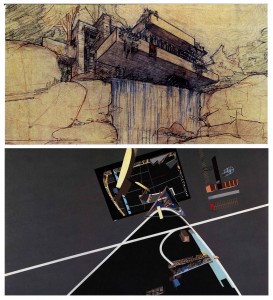Article: Architecture of Atmosphere
Author: Mark Wigley
Publisher: DAIDALOS-Architecture Art Cuture
Issue: June 1998
The Author co-relates the ambiance or function of a space with its atmosphere. Every building has its own atmosphere formed by physical form, sensuous emission of sound, heat, light smell etc. A series of intangible phenomenon generated by stationary object. He also throws light on how representation of drawings helps in determining the atmosphere of a building with example of F.L.Wright’s falling water, where he represented sky, trees and motion of flowing water clearly defines the atmosphere of a building. He also points out object of decor plays an important roll in defining atmosphere of architecture. For example a big hall with chairs and stage creates an atmosphere of auditorium. He also focuses on importance of creating atmosphere architectural education.
It can be inferred that it is very unclear who creates the atmosphere of particular space, Architect ?, object of Decor ? Occupants? or the urban fabric. Through certain examples of modern architecture it can be understood its a collaborative process. Creating an atmosphere all of these play an important role. An Architect’s drawing the first concept line for any project determines the atmosphere of building, Occupants being a part of space and adapting themselves to specific function determines atmosphere of space. The objects of decor defines the atmosphere and lastly the urban fabric, where the space is located in city space creates an atmosphere.
It can be understood through one of the examples of modern architecture. The Bilbao Guggenheim museum by Architect Frank Gehry was conceptualized from crumpled paper. A series of models to understand structure of building were created, also a series of computer tools were developed to bring the project to reality breaking the notion of box architecture. The project was located in industrial area near the river bank and dead in terms of activities. After the completion the space is revived and many other development took place. It also revived the river edge and generated recreational activities. The project act as synthetic gesture ( as mentioned in book Urban Design (edited by Alex Krieger and William S. Saunders) for overall development of area. Hence the building atmosphere revived the surrounding space. Similar is the case with the Oslo opera house by Snohetta, the building has specific purpose of housing opera house but on contrary it acts as recreational facility . The building and users both creates an atmosphere in this case. The drawing representation technique can be a determining factor in atmosphere of architecture. It can be understood by F.L.Wright’s falling water and Zaha hadid’s Irish prime minister’s house project. The earlier is more direct and allows observer to understand the space and environment within which building is located, a sense of climate, a sense of surrounding, on the other hand Zaha hadid defines bold strokes and defines it as more abstract art form. But now a days through modern computation and rendering techniques it is absolutely possible to imitate the atmosphere of space, under a given condition not to fake it.
And hence it would be interesting to research about how each of these individual i.e an architect, occupants, object of decor and urban fabric has specific role for determining the atmosphere of particular space


